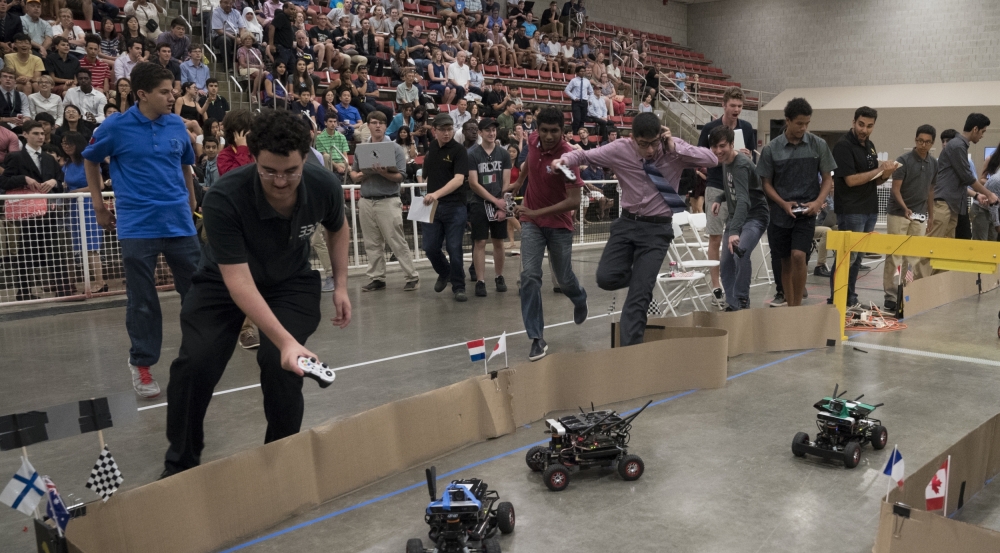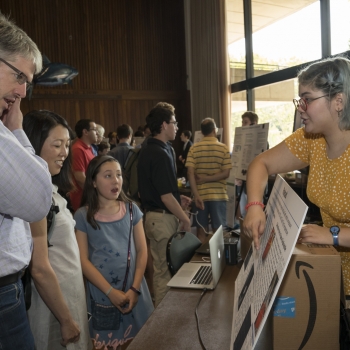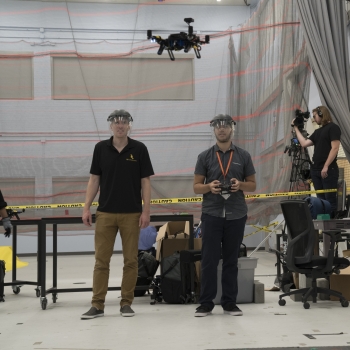Student engineers wrap up transformative summer program
On Sunday, August 5, visitors roaming the MIT Stratton Student Center chatted with high school students stationed at various booths, as 3D printers hummed and a remote-controlled inflatable shark swam above their heads. Down the street at the Johnson Ice Rink, self-driving miniature racecars hurtled down a racetrack while onlookers cheered them on.
This was the scene at the final event of the Beaver Works Summer Institute (BWSI), a four-week summer science, technology, engineering, and math (STEM) program for rising high school seniors. BWSI is an initiative of Beaver Works, a research and education center jointly operated by Lincoln Laboratory and the MIT School of Engineering. BWSI began in 2016 with 46 students; on Sunday, the program concluded its third year with 198 students from 105 schools around the country.

"The Beaver Works Summer Institute is a transformational high school program that finds and attracts talented and motivated students throughout the world to science and engineering. At their core, all our classes offer hands-on, project-based experiences that strengthen the students' understanding of fundamental concepts in emerging technologies of tomorrow," said Professor Sertac Karaman, an academic director of BWSI and an associate professor in MIT's Aeronautics and Astronautics Department.
This year's BWSI featured eight courses: Autonomous RACECAR (Rapid Autonomous Complex-Environment Competing Ackermann-steering Robot) Grand Prix, Autonomous Air Vehicle Racing, Autonomous Cognitive Assistant, Medlytics: Data Science for Health and Medicine, Build a Cubesat, Unmanned Air System–Synthetic Aperture Radar (UAS–SAR), Embedded Security and Hardware Hacking, and Hack a 3D Printer. All courses were supplemented by lectures and an online portion teaching the fundamentals of each topic, which students took prior to arriving at the program.
Students from Mexico, Canada, and Nauset Regional High School in Massachusetts participated in the courses remotely by building the technologies in their own classrooms and listening in on webcasted lectures. At the end of the program, they traveled to the MIT campus to participate in the final event.
At the end of the program, you just look at the things you accomplished and it utterly changes what you think high schoolers, given the right tools and guidance, are capable of.
In the spirit of hands-on learning, students made their own 3D printers and radars, security tested a home door lock system, and designed their own autonomous capabilities for unmanned aerial vehicles (UAVs) and miniature racecars. Despite the challenging nature of the material, the students caught on quickly. "They constantly exceeded my already high expectations. Their ability to immediately engage with what is often graduate-level course materials is inspiring," said Mark Mazumder, a lead instructor of the Autonomous Air Vehicle course and a staff member in the Laboratory's Intelligence and Decision Systems Group. Fellow group staff member and Medlytics lead instructor, Danelle Shah, added, "Not only are these students remarkably bright, but they are ambitious, curious, and passionate about making a difference. They amazed me every day."
After four weeks of learning and building, the students showed off the results of their hard work at the final event. During the first half of the day, the Autonomous RACECAR teams ran time trials at the Johnson Ice Rink in preparation for the final race later in the afternoon. At MIT Building 31, students in the Autonomous Air Vehicle Racing course raced their drones around an LED track, while nearby, drones from the UAS–SAR course used their radar to image an object obscured by a tarp.
Students from the remaining courses set up booths at the Stratton Student Center and talked to visitors about their projects, which included a design for a miniature satellite to be launched by NASA, a 3D printer that could print icing on top of cakes, a cognitive assistant similar to Amazon's Alexa, and a technique for using machine learning to detect cyberbullying on Twitter.
The event culminated in a final grand prix–style race in which the autonomous RACECARs competed to finish an intricate racetrack. Various obstacles such as a windmill and bowling pins were placed on the path, which the cars had to navigate around using a lidar, cameras, and motion sensors that the students integrated into the vehicles. The race was followed by an awards ceremony and closing remarks from the BWSI organizers.
"BWSI 2018 was a huge success, thanks to the passion and dedication of our staff and instructors and the enthusiasm of the students," said Robert Shin, the director of Beaver Works and the head of the Laboratory's ISR and Tactical Systems Division. "In all eight engineering courses, the students far exceeded our expectations in their achievements. That validated our view that there is no limit to what STEM-focused high school students can achieve under the right circumstances. Our vision is to make this opportunity available to all passionate and motivated high school students everywhere."
For many BWSI participants, the program does not end after just four weeks. Nine of this year's associate instructors were former BWSI students, including Karen Nguyen, who now attends MIT. "Before the program, MIT seemed like an unattainable goal. But working with the same autonomous racecars that were used by MIT students and professors allowed me to see that technology could be both advanced and accessible," Nguyen said. Now on the teaching side of the program, Nguyen is still benefiting from it. "By helping instruct high school students on autonomous robotics, I furthered my own knowledge within the field and also learned how to make certain topics in STEM more approachable to a wider range of people."
The organizers of BWSI hope to expand the program in the future by helping schools develop their own local STEM programs based on the BWSI curricula. They are also brainstorming possible new course topics for next year, such as autonomous marine vehicles, disaster relief technologies, and an assistive technology hackathon. Although the third year of BWSI is over, the organizers hope the program will have a lasting impact on the students.
"At the end of the program, you just look at the things you accomplished and it utterly changes what you think high schoolers, given the right tools and guidance, are capable of," said William Shi, a student who participated in the Embedded Security and Hardware Hacking course. "You feel empowered to go out and try your hand at even more ambitious things, to see how far you truly can go."

